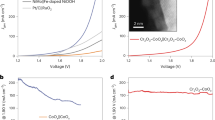Abstract
Biological phosphorus occurs almost exclusively as phosphate in the redox state of + V, although a few phosphonic (+ III) and phosphinic (+ I) acids are found as secondary metabolites1 or as constituents of phosphonolipids. Here we show that a culture of a lithoautotrophic bacterium purified from marine sediments in Venice can grow by anaerobic oxidation of phosphite (+ III) to phosphate (+ V) while simultaneously reducing sulphate to hydrogen sulphide. To our knowledge, this is the first description of a redox reaction involving phosphorus in microbial energy metabolism, an activity that might have operated on the early Earth and which could represent an ancient evolutionary trait.
Similar content being viewed by others
Main
The reduction of phosphate to phosphine (PH3) has to proceed through steps of extremely low redox potential2 (HPO42−/HPO32−,−690 mV; HPO 32−/ H2PO2−, −913 mV; H2PO2−/P, −922 mV; P/PH3, −525 mV, at pH 7.0), so it is unlikely to drive the coupling of a respiratory process to biomass oxidation3,4. Traces of phosphine have been detected in sediments5, paddy fields6 and manure samples4, but their origin is unclear.
Phosphite oxidation to phosphate should provide a good electron source for microbial energy metabolism, however, as the electrons are released at a very low redox potential. Phosphite and hypophosphite can serve as a phosphorus source for aerobic7,8 and anaerobic bacteria9, but so far there has been no evidence for quantitative phosphite oxidation as a type of energy metabolism.
We enriched phosphite-oxidizing, anaerobic bacteria in a sulphide-reduced mineral medium10 with sulphate as the electron acceptor, by using marine or freshwater sediments as inoculum. Growing cultures developed within 2–4 months and were transferred repeatedly into subcultures. Control untreated cultures, or cultures containing autoclaved cells, showed no evidence of phosphite oxidation. We isolated a pure culture of a strictly anaerobic, phosphite-oxidizing sulphate-reducing bacterium, strain FiPS-3, which grew with phosphite plus sulphate and a doubling time of three days according to

where ΔG°′ = − 364 kJ per mol sulphate, or − 91 kJ per mol phosphite.
The strain also oxidized fumarate and malate to CO2, and slowly oxidized hydrogen and formate. Lithotrophic growth with phosphite or hydrogen was not enhanced by addition of acetate, indicating that this strain covers all its carbon assimilation through autotrophic CO2 fixation.
Analysis of 16S ribosomal RNA gene sequences revealed that strain FiPS-3 shares strong sequence similarities with sulphate-reducing Proteobacteria of the δ-subclass and is most closely related to an as-yet undescribed benzene-mineralizing clone SB-9 and to Desulfospira joergensenii, ‘Desulfobacterium phenolicum’ and Desulfobacula toluolica ( Fig. 1).
Scale bar represents 10% estimated difference in nucleotide sequences. DNA from strain FiPS-3 was extracted and purified using standard protocols and the rDNA was sequenced and analysed by using the ARB software package (TU Munich). The topology of the phylogenetic tree was derived from distance-matrix analyses and constructed using a neighbour-joining algorithm. Escherichia coli and Holophaga foetida were used as outgroup references.
The ecological contribution of dissimilatory phosphite oxidation is unclear; on today's oxygen-exposed Earth, phosphite and other reduced inorganic phosphorus compounds are unstable. Phosphite may be an intermediate in the microbial degradation of organophosphonates in anoxic habitats, but there is no evidence for this. In prebiotic and archaean times, reduced phosphorus compounds might have been important as precursors of biochemical phosphorus compounds11, for example, or they may have been introduced by meteorites12. Anaerobically respiring microorganisms like the sulphate-reducing bacterium described here could have thrived on a litho(auto)trophic metabolism involving the oxidation of reduced phosphorus compounds, in which case dissimilatory phosphite oxidation by sulphate-reducing bacteria may represent an ancient evolutionary trait.
References
Ternan, N. G., McGrath, J. W., McMullan, G. & Quinn, J. P. World J. Microbiol. Biotechnol. 14, 635– 647 (1998).
Weast, R. C., Astle, M. J. & Beyer, W. H. (eds) CRC Handbook of Chemistry and Physics (CRC, Boca Raton, FL, 1988).
Devai, I., Felföldy, L., Wittner, I. & Plosz, S. Nature 333, 343–345 ( 1988).
Gassmann, G. & Glindemann, D. Angew. Chem. 32, 761–763 (1993).
Gassmann, G. & Schorn, F. Naturwissenschaften 80 , 78–80 (1993).
Tsubota, G. Soil Plant Food 5, 10–15 (1959).
Malacinski, G. & Konetzka, W. A. J. Bacteriol. 91 , 578–582 (1966).
Metcalf, W. W. & Wolfe, R. S. J. Bacteriol. 180, 5547–5558 (1998).
Foster, T. L., Winans, L. & Elms, S. J. S. Appl. Environ. Microbiol. 35, 937–944 (1978).
Widdel, F. & Pfennig, N. Arch. Microbiol. 129 , 395–400 (1981).
Schwartz, A. W. J. Theor. Biol. 187, 523–527 (1997).
Cooper, G. W., Onwo, W. M. & Cronin, J. R. Geochim. Cosmochim. Acta 56, 4109–4115 (1992).
Author information
Authors and Affiliations
Corresponding author
Rights and permissions
About this article
Cite this article
Schink, B., Friedrich, M. Phosphite oxidation by sulphate reduction . Nature 406, 37 (2000). https://doi.org/10.1038/35017644
Issue Date:
DOI: https://doi.org/10.1038/35017644
This article is cited by
-
Phosphorus availability on the early Earth and the impacts of life
Nature Geoscience (2023)
-
The ProkaBioDen database, a global database of benthic prokaryotic biomasses and densities in the marine realm
Scientific Data (2022)
-
Phosphorus as an integral component of global marine biogeochemistry
Nature Geoscience (2021)
-
Plausible Emergence and Self Assembly of a Primitive Phospholipid from Reduced Phosphorus on the Primordial Earth
Origins of Life and Evolution of Biospheres (2021)
-
Making quantitative sense of electromicrobial production
Nature Catalysis (2019)
Comments
By submitting a comment you agree to abide by our Terms and Community Guidelines. If you find something abusive or that does not comply with our terms or guidelines please flag it as inappropriate.




